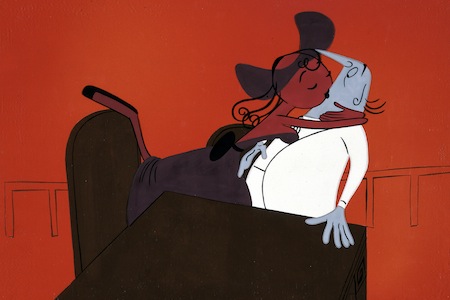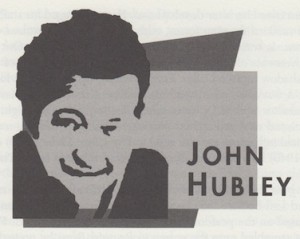Born: May 21, 1914, Marinette, WI
Died: February 23, 1977, New York, NY
Our marriage vow was to make one noncommercial film a year.
—Faith Hubley
For most young animators, working for Walt Disney was the dream of dreams. But for John Hubley, collaborating on Snow White and the Seven Dwarfs (1939), Pinocchio (1940) and Bambi (1942) was unfulfilling. Hubley came to Hollywood in 1935 on a floodtide of new talent that had been recruited to support the Disney studio’s ambitious plans of animated features. He quickly tired of the anthropomorphic characters of Disney’s stories. He despised the detailed drawings. He hated the gag-a-minute mentality and yearned to try the more contemporary approaches practiced by Saul Steinberg and other abstract illustrators. So he left Disney.
The Film 100
1. W.K. Laurie Dickson
2 Edwin S. Porter
3. Charlie Chaplin
4. Mary Pickford
5. Orson Welles
6. Alfred Hitchcock
7. Walt Disney
8. D.W. Griffith
9. Will Hays
10 Thomas Edison
11. John Wayne
12. J.R. Bray
13. Billy Bitzer
14. Jesse Lasky
15. George Eastman
16. Sergei Eisenstein
17. André Bazin
18. Irving Thalberg
19. Thomas Ince
20. Marlon Brando
21. Louis B. Mayer
22. Greta Garbo
23. Robert Flaherty
24. Lon Chaney
25. Anita Loos
26. George Méliès
27. Adolph Zukor
28. John Gilbert
29. Max Fleischer
30. John Ford
31. William Fox
32. George Lucas
33. Linwood Gale Dunn
34. Eadweard Muybridge
35. Katharine Hepburn
36. Winsor McCay
37. Stanley Kubrick
38. Buster Keaton
39. James Agee
40. Fritz Lang
41. Marcus Loew
42. Cedric Gibbons
43. James Cagney
44. Ben Hecht
45. Ingmar Bergman
46. Humphrey Bogart
47. Leon Schlesinger
48. Louella Parsons
49. Roger Corman
50. Edith Head
51. Bernard Herrmann
52. Gary Cooper
53. Mike Todd
54. Ernst Lubitsch
55. Sidney Poitier
56. Saul Bass
57. Billy Wilder
58. Bette Davis
59. Erich von Stroheim
60. Max Factor
61. Auguste and Louis Lumière
62. Woody Allen
63. Clark Gable
64. David O. Selznick
65. Gregg Toland
66. Lillian Gish
67. William Cameron Menzies
68. Lucille Ball
69. Samuel Rothafel
70. Akira Kurosawa
71. Marilyn Monroe
72. Vittorio De Sica
73. Natalie Kalmus
74. Gene Siskel and Roger Ebert
75. Willis O’Brien
76. Shirley Temple
77. Yakima Canutt
78. Sam Peckinpah
79. Jackie Coogan
80. Federico Fellini
81. Leni Riefenstahl
82. Steven Spielberg
83. Sam Warner
84. Jean-Luc Godard
85. Robert De Niro
86. Fred Astaire
87. Francis Ford Coppola
88. Ted Turner
89. Clint Eastwood
90. Dalton Trumbo
91. Dennis Hopper
92. Richard Hollingshead
93. Melvin Van Peebles
94. John Chambers
95. Mack Sennett
96. Martin Scorsese
97. Karl Struss
98. Busby Berkeley
99. John Hubley
100. John Cassavetes
Hubley joined the newly formed First Motion Picture Unit (FMPU) in 1941 and moonlighted on a series at Columbia Pictures. He was not afraid to voice his personal opinions and expounded the possibilities of a new movement in animation. Earning the respect of his new colleagues, Hubley played a vital role in the newborn United Productions of America (UPA), a studio he cofounded when FMPU sold off its animation division. Under his leadership, UPA became the monogram for fiercely independent cartoons. While other studios rushed to keep up with Disney’s standards, UPA went the other way entirely.
As supervising director of UPA, Hubley was vocal about the direction the studio needed to take. He embraced a stark style that emphasized story development over character development. He encouraged his staff to experiment with modern drawing forms, odd angles, unusual textures and color combinations. It was a clean slate; the rules were all gone. Out were the smooth movements of Disney. Out were the 3-D backgrounds of Fleischer. Light and shadow replaced color. Fuzzy, floating shapes stood in for baroque backdrops. A wavy line could symbolize a tree. Knees did not have to bend when a character walked. A transparent, floating rectangle might suddenly sprout a pointed roof and arched doorway, instantly producing a doghouse. These seminal influences are best seen in The Magic Fluke (1949) and Robin Hoodlum (1949), two interpretations of the same Grimm fable “The Fox and the Crow.”
Searching for the antithesis of cute animal characters, Hubley introduced a befuddled and bullheaded character half inspired by an eccentric uncle and half based on the persona of vaudevillian screen star W.C. Fields. Mr. Magoo first stumbled onto the screen in Ragtime Bear; he proved so popular that he would be resurrected in Spellbound Hound (1950) and Fuddy Duddy Buddy (1951).
By 1951, Hubley and UPA had turned the animation world on its ear. Because they were a fledgling group trying to compete with established studios, Hubley eliminated much of the work required in cel-based animation while retaining the style’s look. They worked smarter, cutting costs significantly in their production by a process dubbed “limited animation.” Rather than create twenty-four frames for every second of film, they used fifteen frames per second. Rich, lavish background paintings were reduced to shapes of color and repeated often. This studio model worked well within restrictive budgets, generating compelling, lively films for a fraction of the cost of rival shorts. When television forced theatrical film studios to cut costs, they quickly adopted limited animation techniques, and to do it convincingly, they borrowed heavily from Hubley’s examples. Limited animation became the predominant production method in the industry and is used almost exclusively in animated television programming today.
Successful films like Gerald McBoing Boing (1951) and Rooty Toot Toot (1952) signaled that limited animation techniques did not shave time and money at the expense of entertainment. With Rooty Toot Toot, a highly stylized Frankie and Johnnie spoof set to jazz music, Hubley won an Academy Award and commanded the attention of his peers. Ironically, Rooty Toot Toot would be Hubley’s last for UPA, but by then he had already created a worldwide shake-up.
His cartoon sequences for live-action films, including The Four Poster (1952), would inspire Saul Bass and other graphic designers to rethink title sequences. The Zagreb studios of Czechoslovakia revered him and imitated his stark, graphic look. Most important, his inventive processes were efficient. Every major cartoon studio, including Disney, would go back to their storyboards and adopt the economical style to compete with television studios that were learning the time-saving tricks of UPA’s limited animation. Even master character animator Chuck Jones’s The Dot and the Line (1964) owed a debt to Hubley’s work.
In 1955, Hubley left UPA under the dark cloud of McCarthyism and created his own studio. His wife Faith became a full-time collaborator and helped him start Storyboard, their own cartoon production company. Some of their most experimental and personal films were made independently. Oscar-winning shorts like Moonbird (1959), The Hole (1962) and The Windy Day (1967) further inspired a new breed of animators. These films cleverly used sound recordings of the Hubleys’ children at play; animated sequences accompanied the touching, innocent words of the soundtrack, bringing their fanciful comments and colorful dreams to life. Shown on college campuses and at animation festivals, these celebrated works were accompanied by other showcase cartoons from around the world. By the 1970s, a grass-roots movement had secured a place for short films, and today’s independent animators enjoy international fame and commercial success largely due to these early groundbreaking films.
John Hubley remains the most significant animator in the second half of the twentieth century. No other single person has done more to free the form of its early stylistic constraints, to bring creative individuals to the craft, and to make animated films a deeply personal art.
To read all the republished articles from ‘The Film 100,’ go to Reintroducing the Film 100 here on Keyframe.





